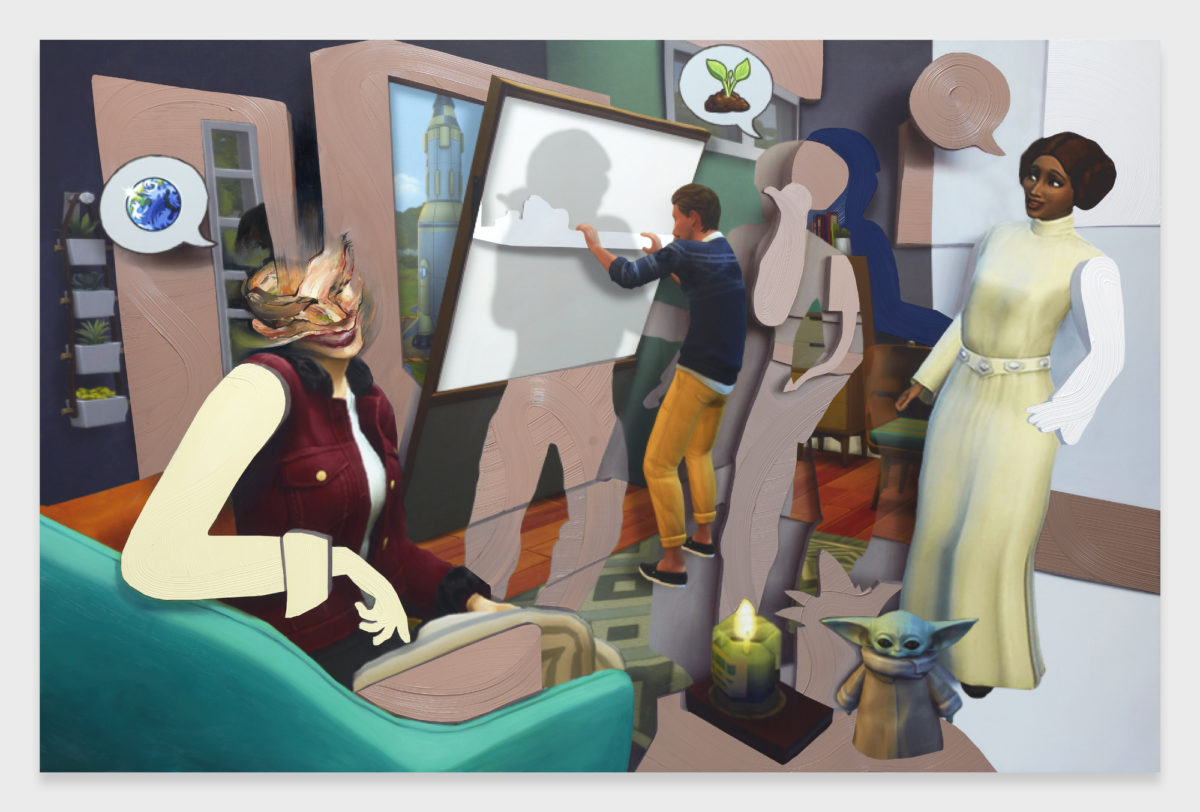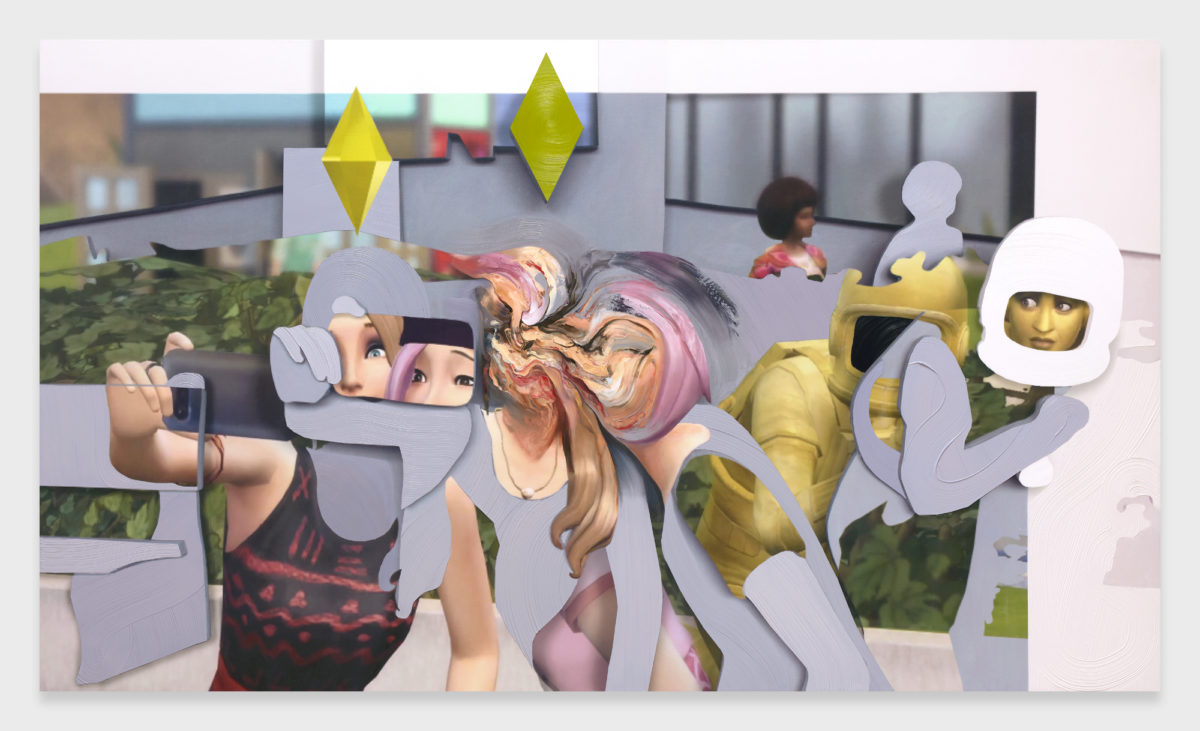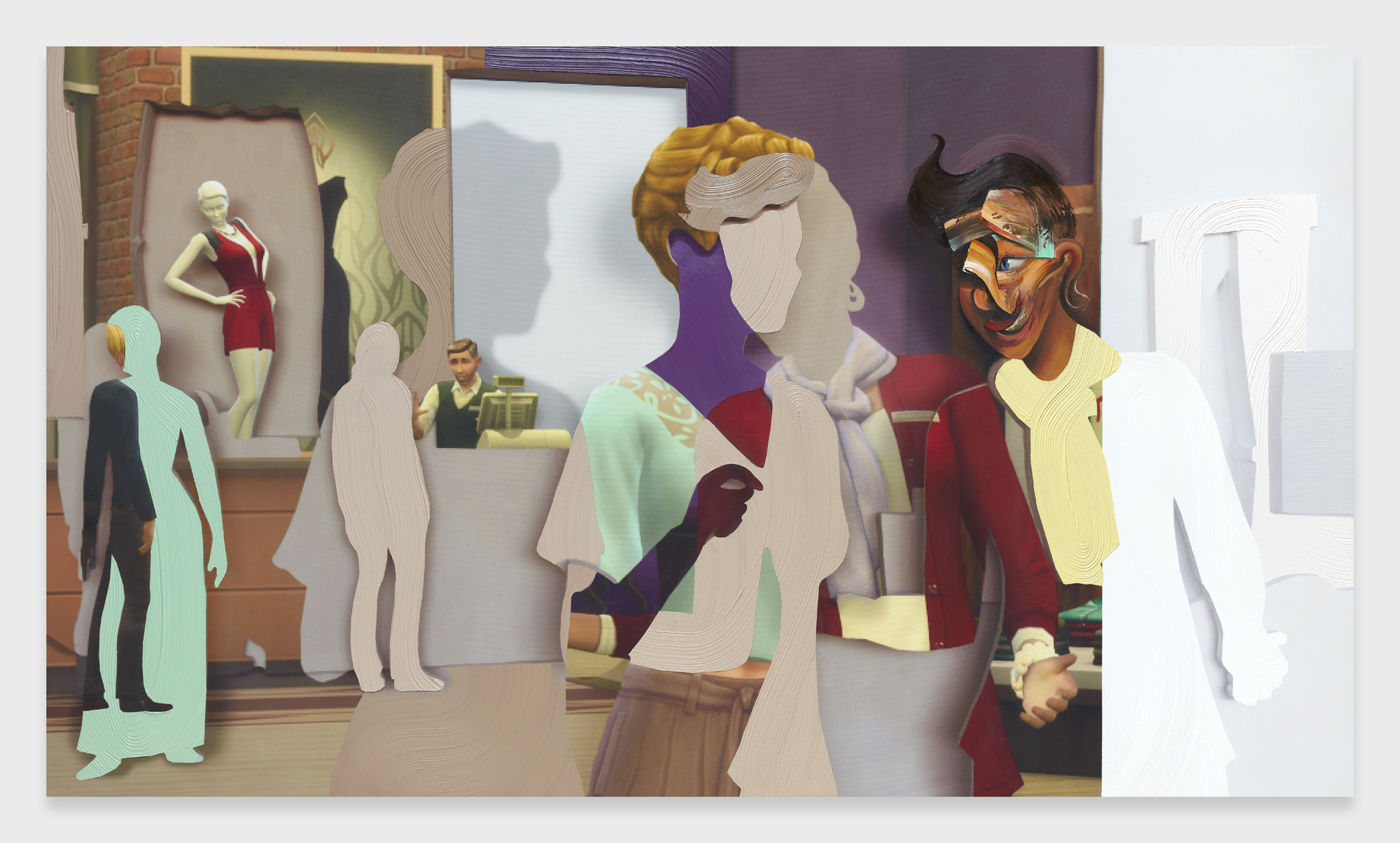
There is something undeniably terrifying about Pieter Schoolwerth’s works, which combine the clean lines and poreless skin of digital avatars with violent slashes of paint and empty outlines of human forms. The American artist’s latest series of works has stemmed from his own time in lockdown, and 2020’s highly digital human contact. There is some form of façade in all of his pieces, in which the viewer sees cracks but no clear image of what lies behind.
Schoolwerth’s characters find themselves in absurd situations, as everyday living room or high street scenes are punctured with geometric forms, emoji-like speech bubbles and contemporary cultural icons such as Baby Yoda. The works don’t reveal the fakeness of the digital world so much as convey how intermingled the digital and IRL self has become. “I feel more and more that these two realities are inseparable, and as a result it’s literally impossible to go offline,” he tells me, as his show Shifted Sims opens at Petzel in New York.
- Shifted Sims #9 (Eco Lifestyle), 2020
Shifted Sims has a focus on digital masks, and touches on feelings of estrangement brought about by this year of lockdown and isolation. What was your personal experience of this time, and how has this fed into the work?
I created most of the paintings in Shifted Sims during the lockdown in New York. In putting on a mask each day to perform the same banal tasks on Zoom that just a few weeks before I had done in person, I began to feel I was living a simulation of my former life, navigating my avatar through each day. I would look out of my studio window to see anxious masked strangers rushing past each other on the sidewalk, avoiding physical contact or even acknowledgement, and this intense feeling of detached isolation began to resemble the alienating clusters of anonymous profile icons on WhatsApp or social comment threads scrolling across my feed. The pandemic has taken a tragic toll on human life and entirely changed the way in which we interact. It has brought the mask we have been living behind virtually for decades to the surface.
“The fantasy of logging off has become an analogue luxury lifestyle choice that most working people cannot afford”
It made sense to set my entire show within the life simulation game The Sims 4. Since its inception in 2000, The Sims has proved to be a properly timeworn digital environment, which was prescient as a blueprint for social media and living life from a distance. Players construct their body and personality from the ground up to perform any identity and form of presence they desire.
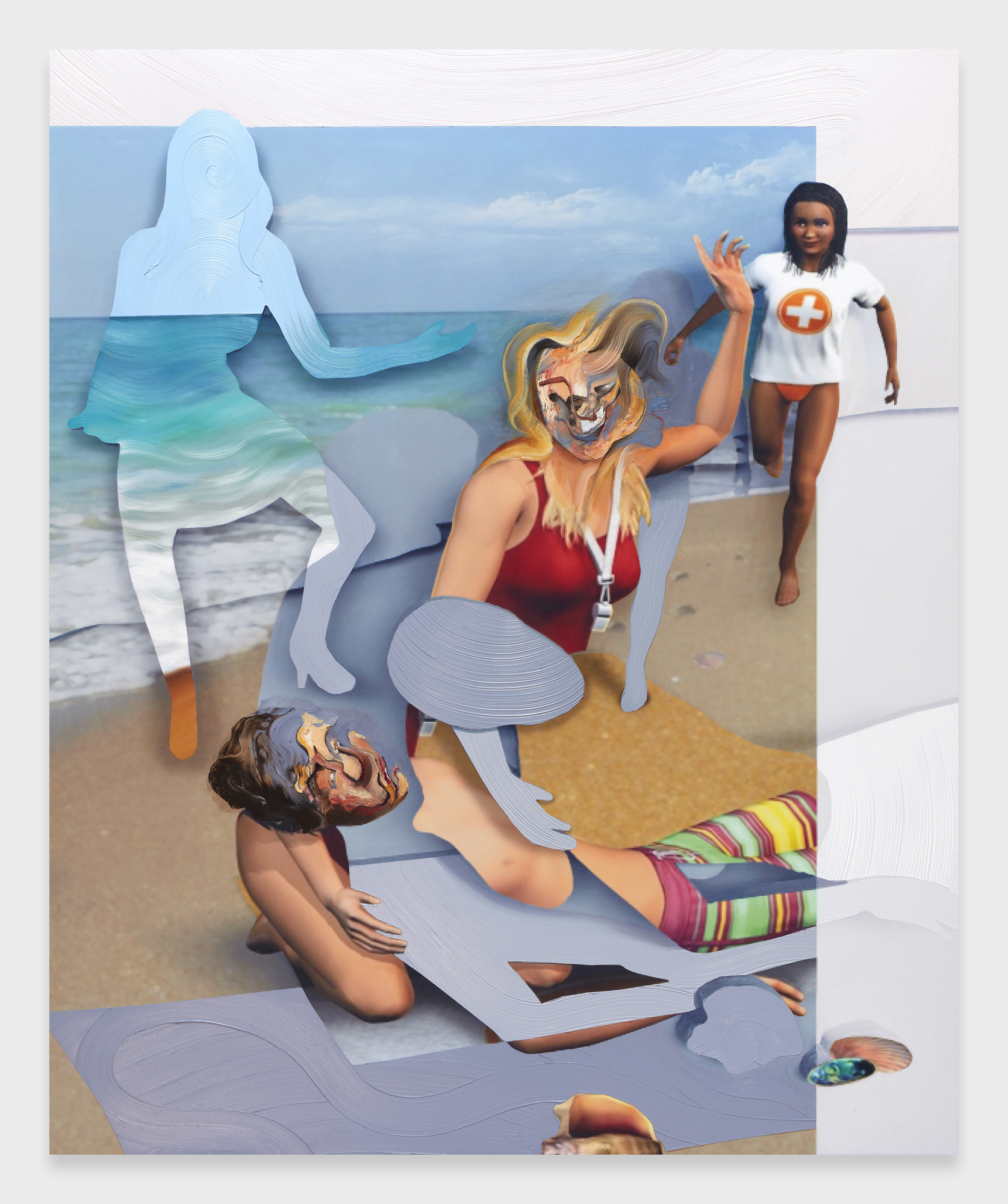
Can you talk me through your process for these works? I know you begin with relief models. Once you get to the more expressive painted elements, do you work quite intuitively or is it all planned out in advance?
Each painting begins from a narrative screenshot, depicting avatars I find online interacting, often in Sims forums and chatrooms. Some are appropriated without alteration, and others I collage together from my archive. I translate the screenshot into 3D by building a sculptural relief model out of foamcore, which I photograph, and using the computer I overlay the screenshot back onto the model. Before I embed fragments of the screenshot back into the model digitally, I shift the screenshot off its 3D copy, making it slightly askew, which results in a doubling effect; each figure appears twice in the resulting image I print out on canvas, and I distribute the various body parts between the printed body and an empty silhouette that follows closely behind each figure. As a last step, which I think of as similar to enhancing a captured photo, I apply gestural passages of paint on top of the inkjet to put my hand back into the painting.
I paint the heads quite spontaneously, improvising them often in one sitting, which I think of as adding a human element to the composition. The language I use to depict the space around the avatars is quite different: measured, taped-off and tightly controlled to suggest the smoothly flowing, data-harvested and monetised space of networked infrastructure that surrounds us today.
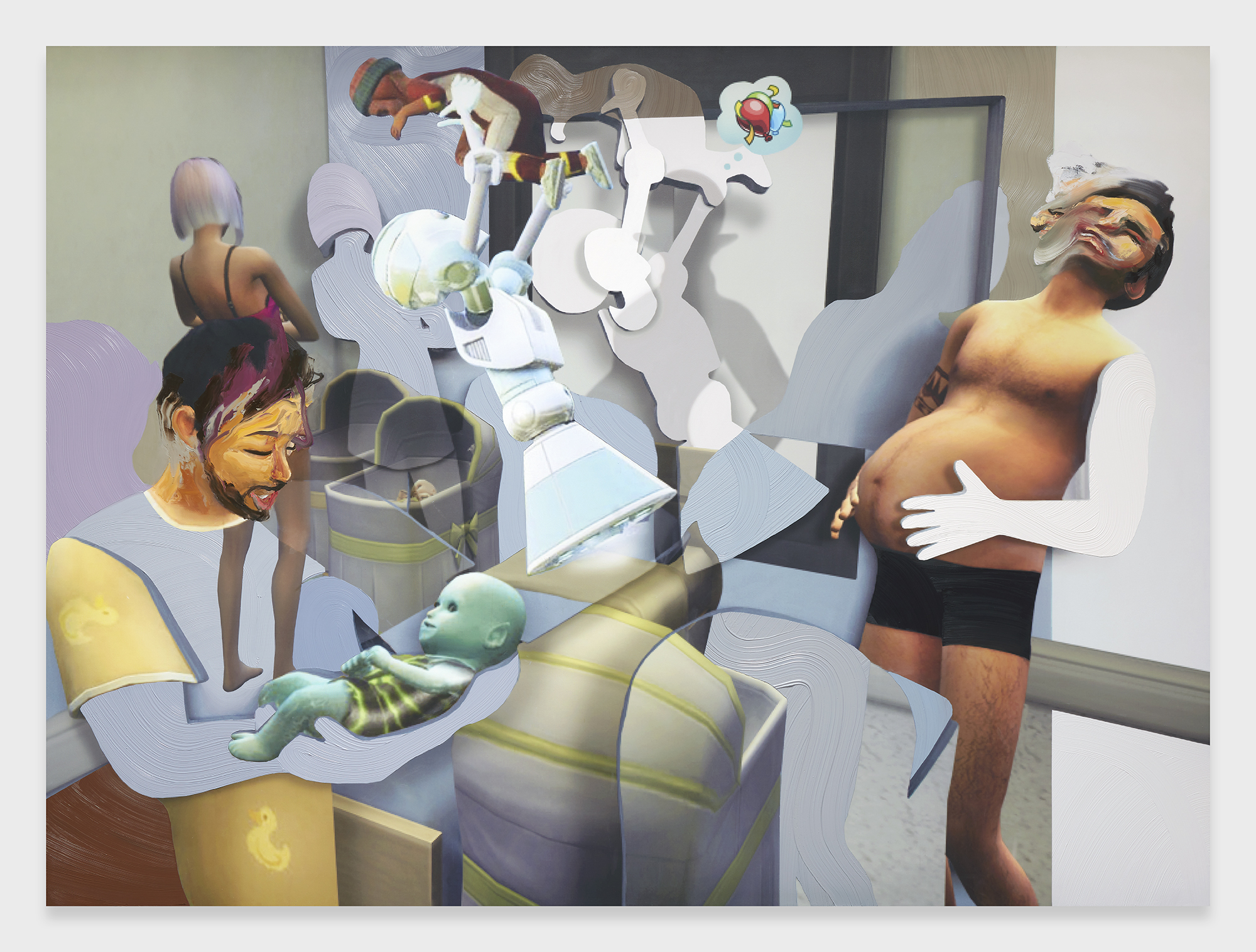
The slippage between 2D and 3D, real-world and digital realms at times feels violent in your recent works. There is one particular face which looks as though it is cracking down the front, with a whole different expression bursting from it. It seems as though many of the digital elements are very clean and controlled, but we see shots of intense human emotion breaking through in the more painterly aspects. How do you think our behaviour and self-expression differs between the digital world and the ‘real’ world?
I’m glad you noticed the ‘crack’ in the YouTuber Career figure, as it’s an example of the fraught inner dynamics of avatar life that I’m representing in the bodies, which have an intrinsically shifty form of presence. Anyone can slip in and out to inhabit a profile today, and those interacting with them often have no idea who’s behind the image on the other side. This frees the player from the constraints of their corporeal body. This could be seen as a vehicle for digital fantasy, but it also enables trolling, shaming and other forms of online harassment. Trying to capture this shadow body that we perform, in paint, presents an intriguing challenge to the historical rhetoric of expressionism, and modernist notions of gestural ‘authenticity’ in particular. How can I depict a body that is being navigated by another?
“The pandemic has taken a tragic toll on human life and entirely changed the way in which we interact”
There are references to items such as Impossible Burgers in your work, which while not a creation of the digital realm, still have that sense of one thing imitating another; a knock off of the real thing. Do you see the idea of the façade invading much of contemporary life?
Recently I have come to feel that we’re living in an augmented reality; our presence in the world is split between our in-person interactions and our activities in the ether. We bring the knowledge we gain of others’ platform performances to our physical interactions with them in order to form an idea of their being. Where a decade or so ago I thought of this split as a kind of dualistic existence, now I feel more and more that these two realities are inseparable, and as a result it’s literally impossible to go offline. The fantasy of logging off has become an analogue luxury lifestyle choice that most working people cannot afford, and even when you do take a break, your broken ghost is haunting the chapel of networks, more alive and vulnerable than ever, being shared, tagged and commented on.
- Shifted Sims #1 (Get Together), 2020
How do you feel the role of painting and canvas-based work has changed in the digital age? And what new things have you learned about painting through working in this way?
I don’t think the forces of technological abstraction that create a feeling of distance in life today have any effect on the question of an originary locus of ‘reality’. Philosophers have been pondering this for centuries, but the augmented form that the body presents itself in now does feel quite different from the one (those of us old enough to remember) inhabited and performed before the digital era. A more urgent question for painting might be is it still possible to innovate (and are artists even interested in the notion of innovation) at the level of form? More specifically, in proposing new models of visual space in 2020, is it possible to present a compelling visual experience for the jaded viewer who is totally burnt out from the daily data overload that many people endure on the screen?
“How can I depict a body that is being navigated by another?”
Representing the tension inherent in the disconnect between the digital and actual realms today is an important subject for art, and one I took on in my painting Shifted Sims #13 (Covid-19 Expansion Pack), which depicts a narrative scene of figures infected and struggling with the virus. I wanted to make an updated history painting couched in the contemporary visual language of memes, emojis and simulation games to memorialise the experience I’ve had alone in my studio, and with my partner, over the past six months.
There is a mobile morgue a few blocks away from my studio, which I would see bodies entering. The refrigeration generator blared on my ride home each day, after scrolling past endless sardonically cynical ‘Quarantini lol’-style memes about Covid on my phone hours before. The avatars in my painting are screaming as their friends and loved ones suffer, and pass on, but were they ever really alive in the first place to make a sound?
